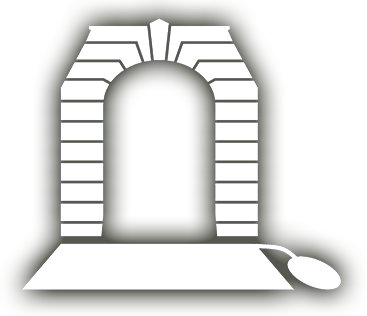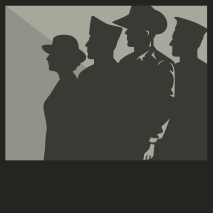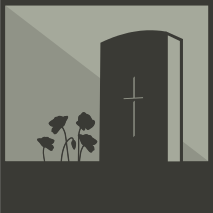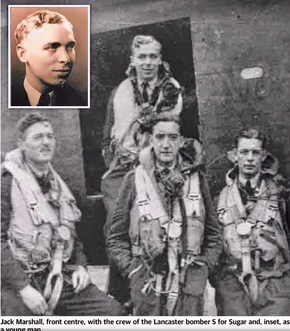MARSHALL, John Francis
| Service Number: | 416445 |
|---|---|
| Enlisted: | 23 June 1941 |
| Last Rank: | Flying Officer |
| Last Unit: | Not yet discovered |
| Born: | Clarence Park, South Australia, 18 October 1920 |
| Home Town: | Not yet discovered |
| Schooling: | Not yet discovered |
| Occupation: | Not yet discovered |
| Died: | Natural Causes, Brighton, South Australia, 2 January 2022, aged 101 years |
| Cemetery: | Not yet discovered |
| Memorials: |
World War 2 Service
| 23 Jun 1941: | Involvement Flying Officer, 416445 | |
|---|---|---|
| 23 Jun 1941: | Enlisted Adelaide, SA | |
| 23 Jun 1941: | Enlisted Royal Australian Air Force, Flying Officer, 416445 | |
| 28 Sep 1945: | Discharged | |
| Date unknown: | Honoured Distinguished Flying Cross |
Navigator became a hero of the skies
Jack Marshall was a celebrated World War II air force navigator who flew close to 100 missions into enemy territory.
Born John, but always known as Jack, he lived in Clarence Park with his parents until enlisting in the Royal Australian Air Force. His father was not happy to learn of Jack joining up, as he had been badly wounded while serving as a gunner on the Western Front during World War I.
Before joining up, Jack worked several jobs including in a lawyer’s office. He had never seen an aircraft before he enlisted in June 1941.
Jack trained as a Tiger Moth pilot at Parafield, but navigators were needed. This was because Lancaster night bombers were rarely hitting targets, with many bombs dropping short. He trained at Victor Harbor, Port Pirie, Mallala and Nhill in Victoria, where he got his wings as a sergeant.
He left on the ship Klipfontaine to San Francisco, US, then on to Edmonton, Canada, where he saw snow for the first time. He sailed to Liverpool, UK, and for nearly two years served in north Scotland.
Jack, two other Australians, an Englishman and a Canadian joined a squadron of the newly formed Pathfinder Force flying Lancaster heavy bombers. They pinpointed target areas in advance of the mass of bombers by lighting the area with green flares to help avoid heavy loss of aircraft.
Finally, with their aircraft “S for Sugar” (under the command of RAAF Flying Officer Roy Roberts, DFC and BAR, later Wing Commander), they bombed Germany and occupied France.
They completed 60 operations, and then continued with more.
Their aircraft from time to time received great battle damage.
On a raid to Bonn in Germany on December 28, 1944, it was hit hard, and flight engineer George Hatton was seriously wounded. The aircraft, riddled with flak damage and bullet holes, was lucky to make it back.
However, things were to change.
On September 24, 1944, the crew had their late breakfast of powdered eggs, toast and tea, and were told to attend a special briefing. They learned they were no longer to be flying night raids, but lowlevel daylight raids over Calais in support of the British Army.
The main target would be the German Army and its headquarters near the Calais Cathedral.
Later that day, they were given their operation meal of two eggs, toast and tea, and headed across the channel.
They had been briefed to act as a master-bomber crew, to mark, bomb and wipe out a heavily defended German strong point with gun batteries, which was going to require low-level and pinpoint accuracy to guide the rest of the Lancasters.
They were required to bomb and mark six other designated targets around Calais that day. Their aircraft took hits from flak and ground fire, flying low in bad visibility caused by smoke and dust, and just avoiding hitting a sand dune. They lost two engines, and a third after crossing the Channel. The last engine quit as they were coming in to land.
They nearly collided with a petrol tanker. S for Sugar was a complete write-off.
The crew was given leave every six weeks, and at times were guests at a country house, where they enjoyed good food and hospitality.
They were given a new aircraft, “R for Robert”, and eventually went back to night bombing operation until the end of the war.
By then, Jack had been promoted to Flying Officer.
Jack returned to Australia, married his long-time girlfriend Joan, settled down and raised a family of four.
Following in his father’s footsteps, Jack took a job with the Repatriation Department.
He stayed active, including becoming a member of the Brighton Surf Life Saving Club and winning a bronze medal and merit award.
Jack took a keen interest in fowl and bird keeping, went to meetings of a bird society, and wrote articles for the society’s monthly magazine.
Joan died in 2014. Jack later moved to Brighton Aged Care, where he was a well-liked and respected resident. He enjoyed frequent visits from his children and grandchildren. He remained in good health, and enjoyed his 101st birthday with a small family gathering.
Jack is survived by children John, Kay, Ann, Craig, five grandchildren and one great grandchild.
Adelaide Advertiser Obituary - 19th February 2022
Submitted 20 February 2022 by Trevor Thomas










